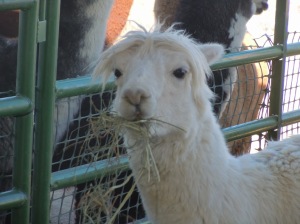Hi – it’s Aunt Geri. Here is my latest creation (aside from the Chimayo yarn that I continue to pump out). This is a green “Magic” scarf made with baby alpaca and a variegated nylon ribbon. I think it’s the result of spring fever – even though this scarf is super warm and cuddly soft. I plan on knitting a matching hat similar to hats we saw in a high-end boutique in Santa Fe.
- I never saw a green alpaca
- I never hope to see one
- But I can tell you anyhow
- The green is just not seen!
All humor aside, we have had customers ask us if Cliff House “…has green alpacas…”. In a sense, we do – since alpacas rate among the world’s “greenest” creatures. Their padded feet are gentle on the soil and they don’t require a lot of “range”. They eat less food than horses or cows, and when grazing, no roots are pulled up (AH – the destructive wars between cattlemen and sheep herders in Wyoming!). Alpacas have lower incisor teeth and an upper dental pad with no teeth. They hold the grass between their lower teeth and upper pad and a simple turn of their head does the trick. A 3-compartment stomach efficiently converts grass and hay into energy.
Manure is deposited in only one or two spots by the herd, providing natural control of parasites. Alpaca manure may be applied directly to gardens because all the carbon material has been digested before elimination. Cliff House composts their Paca Poo, and calls it “Alpaca Gold”. Our alpaca manure is composted because it’s mixed in with horse manure and shavings: time breaks it down to create an organic fertilizer for plants.
To take “green” one step further, wear some alpaca, and turn down the thermostat.




Very interesting facts about the alpacas, none of which I knew before, thank you. I love the scarf, which has beautiful long fringes and does indeed look very soft and warm.
The fringe is my favorite part too! Even though I know it’s not the part that takes the skill, time or patience. I’m easily distracted by shiny things.
Pingback: The Green Alpaca – part deaux | Cliff House Alpacas